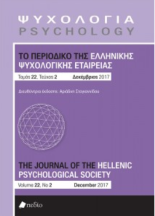Η ψυχομετρική αξιολόγηση μίας κλίμακας για την εκτίμηση της διαταραχής από τη συμμετοχή σε τυχερά παίγνια

Περίληψη
Ο σκοπός αυτής της μελέτης ήταν ο ψυχομετρικός έλεγχος της ελληνικής έκδοσης ερωτηματολογίου που στηρίζεται στα διαγνωστικά κριτήρια του DSM-5 για τη Διαταραχή από τη Συμμετοχή σε τυχερά Παίγνια, ώστε να αποτελέσει εργαλείο σε κλινικές και επιδημιολογικές μελέτες που διεξάγονται στην Ελλάδα. Η μελέτη βασίστηκε σε ανώνυμο ερωτηματολόγιο στο οποίο εμφανίζονται με μορφή ερωτήσεων τα διαγνωστικά κριτήρια. Ο ερωτώμενος επιλέγει την απάντησή του που είναι είτε ναι είτε όχι και η βαθμολογία προκύπτει από το άθροισμα των επιμέρους βαθμολογιών ανάλογα με την απάντηση. Οι απαντήσεις είναι ισοβαρείς και το συνολικό αποτέλεσμα (score) κυμαίνεται, θεωρητικά, από μηδέν έως εννέα (0-9). Οι ερωτήσεις αφορούν το χρονικό διάστημα των τελευταίων δώδεκα μηνών. Το ερωτηματολόγιο αξιολογήθηκε ως προς την εγκυρότητα της δομής του, την αξιοπιστία του, αλλά και την ομοιογένεια των απαντήσεων τριών ομάδων, τα μέλη των οποίων επιλέχθηκαν τυχαία μέσα από τον γενικό πληθυσμό, τα μητρώα των παρόχων τυχερών παιγνίων και τα σημεία πώλησης, και τους
Ανώνυμους Τζογαδόρους. Οι ομάδες συμπλήρωσαν το ερωτηματολόγιο της έρευνας που αποτελείται από δύο μέρη αφενός όσο αφορά τα δημογραφικά χαρακτηριστικά και αφετέρου το κυρίως ερωτηματολόγιο, την ελληνική εκδοχή των διαγνωστικών κριτήριων του DSM-5 για τη Διαταραχή Συμμετοχής σε τυχερά Παίγνια.
Για τον ψυχομετρικό έλεγχο του ερωτηματολογίου λήφθηκαν υπόψη α) η εσωτερική αξιοπιστία του ερωτηματολογίου (συντελεστής Cronbach’s α και δείκτης omega ), β) η ανάλυση κυρίων παραγόντων, η οποία
ανέδειξε μία συνιστώσα, και γ) η επιβεβαιωτική ανάλυση παραγόντων, η οποία ήταν στατιστικά σημαντική (p < 0,001), με τιμές από 0,657 μέχρι 0,855. Η ελληνική έκδοση των διαγνωστικών κριτηρίων του DSM-5 για
τη Διαταραχή από τη Συμμετοχή σε τυχερά Παίγνια, μέτρησε αποτελεσματικά την επίπτωση που έχει η συμμετοχή σε τυχερά παιχνίδια στην ψυχική υγεία, γεγονός που συμβάλλει στην υιοθέτηση αυτών ως έγκυρη και αξιόπιστη κλίμακα.
Λεπτομέρειες άρθρου
- Πώς να δημιουργήσετε Αναφορές
-
Βάσιος Α. Λ., & Ρούσσος Π. Λ. (2017). Η ψυχομετρική αξιολόγηση μίας κλίμακας για την εκτίμηση της διαταραχής από τη συμμετοχή σε τυχερά παίγνια. Ψυχολογία: το περιοδικό της Ελληνικής Ψυχολογικής Εταιρείας, 22(2), 54–70. https://doi.org/10.12681/psy_hps.23255
- Τεύχος
- Τόμ. 22 Αρ. 2 (2017)
- Ενότητα
- ΕΜΠΕΙΡΙΚΕΣ ΕΡΓΑΣΙΕΣ

Αυτή η εργασία είναι αδειοδοτημένη υπό το Creative Commons Attribution-ShareAlike 4.0 International License.
Το περιοδικό ΨΥΧΟΛΟΓΙΑ έχει υιοθετήσει μία πολιτική Platinum open-access. Τα έξοδα υποβολής, επεξεργασίας ή δημοσίευσης των εργασιών καλύπτονται από την Ελληνική Ψυχολογική Εταιρεία. Τα πνευματικά δικαιώματα των δημοσιευμένων εργασιών προστατεύονται από την άδεια 'Creative Commons Attribution-ShareAlike 4.0 International'. Οι Συγγραφείς διατηρούν τα Πνευματικά Δικαιώματα και χορηγούν στο περιοδικό το δικαίωμα της πρώτης δημοσίευσης. Η άδεια αυτή επιτρέπει σε τρίτους, να χρησιμοποιούν την εργασία σε οποιαδήποτε μορφή, με την προϋπόθεση της διατήρησης των διατυπώσεων που προβλέπονται στην άδεια σχετικά με την αναφορά στον αρχικό δημιουργό και την αρχική δημοσίευση στο περιοδικό ΨΥΧΟΛΟΓΙΑ. Επιπλέον, κάθε διανομή της εργασίας οφείλει να γίνεται με τους ίδιους όρους διανομής, δηλαδή με την ίδια άδεια Creative Commons.


